
Recipe for Neer Mor: Authentic South Indian Buttermilk
### Neer Mor: A Cool South Indian Buttermilk Beverage Recipe
Neer mor, or Neer moru in Tamil, is a classic South Indian buttermilk drink known for being a revitalizing option during the warm summer season. This refreshing drink is mainly prepared with fresh, thick curd and enhanced with green chilies, ginger, and curry leaves, making it both wholesome and tasty.
#### What is Neer Mor?
Neer mor is a savory yogurt drink that contrasts with its sweeter variant, lassi. With a high water content, akin to chaas or mattha, it is cherished for its lightness and easy digestibility. It goes by different names in various South Indian languages, such as majjiga in Telugu, majjige in Kannada, and sambaram in Malayalam. This beverage is not merely a household staple in South India but also holds significant cultural and religious relevance.
#### Cultural Significance
In numerous South Indian families, particularly during the hotter months, mothers and grandmothers prepare neer mor in earthen pots. This drink is not only served to family members but also shared with guests, underlining its role in hospitality. Neer mor is frequently presented at the conclusion of a meal to aid digestion, making it a vital component of a traditional South Indian thali. The probiotic qualities of buttermilk contribute to hydrating the body and alleviating fatigue and excessive perspiration.
During festivals such as Sri Ram Navami, neer mor is presented to Lord Rama alongside vadapappu panakam. It is also made to mark the Tamil New Year, which occurs on April 14th.
#### Ingredients and Preparation
To prepare neer mor, the typical ingredients include:
– Fresh thick curd (yogurt)
– Water
– Green chilies
– Ginger
– Curry leaves
– Salt (to taste)
The process of making neer mor can differ between households, with each cook having their distinct spice mix. Some might create a paste using green chilies and ginger, while others might prefer simply adding slit or chopped green chilies and grated ginger directly to the buttermilk.
Here is a straightforward method to prepare neer mor:
1. **Ingredients**:
– 1 cup fresh thick curd
– 2 cups water (modify for preferred thickness)
– 1-2 green chilies, slit or chopped
– 1-inch piece of ginger, grated
– A few curry leaves
– Salt to taste
2. **Instructions**:
1. In a mixing bowl, whisk the fresh curd until it becomes smooth.
2. Gradually add water to reach the desired consistency.
3. Mix in the slit green chilies, grated ginger, and salt.
4. Let the mixture sit for a few minutes to blend the flavors.
5. Optionally, you may temper mustard seeds, asafoetida, and curry leaves in a small amount of oil and incorporate this into the buttermilk for an added flavor dimension.
6. Serve chilled, removing the green chilies if preferred.
#### Variations
Though the fundamental recipe is quite simple, there are numerous variations. Some households may incorporate a tempering of mustard seeds and curry leaves, enriching the flavor profile. Using fresh, well-set thick curd along with freshly gathered herbs is essential to truly enjoy the essence of neer mor.
#### Conclusion
Neer mor is not merely a drink; it represents a cultural emblem of hospitality and tradition in South India. Its health advantages, refreshing flavor, and simple preparation render it one of the finest summer beverages. Whether savored at home or offered to visitors, neer mor is a delightful method to keep cool and hydrated throughout the scorching summer months.
Read More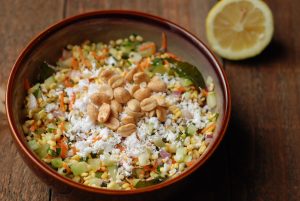
Moong Dal Salad: A Kosambari Recipe
### Kosambari: A Wholesome Moong Dal Salad from Karnataka
Kosambari, referred to as kosumalli or hesarubele kosambari, is a delightful and protein-packed lentil salad that occupies a prominent role in Kannada culinary tradition. This uncomplicated yet tasty dish is frequently made during festive events, particularly as neivedhyam (offering) to Lord Rama during the Sri Ram Navami celebration. It is also relished during weddings and various festivities, establishing it as a fundamental component in South Indian homes.
#### Ingredients and Variations
The fundamental recipe for Kosambari features soaked moong dal (split green gram) and cucumber. Nonetheless, it can be easily tailored with extra ingredients like grated carrot and raw mango, which enrich its taste and nutritional benefits. The soaking of moong dal not only facilitates digestion but also amplifies its health benefits, rendering Kosambari an outstanding option for those in search of a nutritious meal.
#### Preparation and Serving
Kosambari is quick and straightforward to prepare, typically requiring just a few minutes to put together. The salad can be enjoyed as a standalone dish, particularly when accompanied by a refreshing glass of neer mor (South Indian buttermilk). For those who appreciate a hint of tempering, mustard seeds and curry leaves can be included, though the salad remains equally delightful without them.
The mixture of crunchy cucumber, sweet coconut, and zesty lemon juice forms a harmonious fusion of flavors and textures. Fresh coriander leaves not only contribute a burst of color but also elevate the overall flavor, making Kosambari a visually attractive dish.
#### Nutritional Benefits
As a protein-rich salad, Kosambari is an excellent choice for those aiming to uphold a healthy diet or manage weight. Its light yet satisfying nature makes it fitting for many occasions, including fasting during Navratri. The dish is also vegan, appealing to a broad spectrum of dietary preferences.
#### Storage
One of the benefits of Kosambari is its capacity to be stored well in the refrigerator, facilitating easy meal preparation and leftovers.
### Conclusion
Kosambari transcends the notion of a mere salad; it is a celebration of flavors and nutrition that encapsulates the spirit of Kannada cuisine. Whether savored during festivities or as a wholesome meal, this straightforward moong dal salad is sure to delight the taste buds and nourish the body.
Read More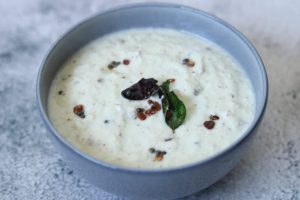
Mamidikaya Perugu Pachadi: Andhra-Style Ripe Mango Relish Recipe
### Mamidipandu Perugu Pachadi: A Refreshing Andhra Style Sweet Mango Yogurt Chutney
Mamidipandu perugu pachadi is an enchanting Andhra-style chutney that merges ripe mangoes with yogurt, making it an ideal dish to relish during the blazing summer days. This sweet mango yogurt chutney is not only invigorating but also delivers a distinctive flavor profile that can stand as a meal on its own.
#### The Essence of Mamidipandu Perugu Pachadi
This chutney primarily consists of ripe mangoes, especially the Suvarnarekha variety, celebrated for its sweetness and taste. The fusion of creamy yogurt and the inherent sweetness of mangoes results in a delectably smooth consistency. The incorporation of tempered spices, like red chilies and curry leaves, differentiates it from North Indian raita, which typically lacks this flavorful enhancement.
#### Nutritional Benefits
Mamidipandu perugu pachadi is not merely a delight for the palate; it also offers numerous health advantages. It is abundant in calcium due to the yogurt, provides probiotics for digestive health, and is rich in fiber and antioxidants from the mangoes. This makes it a nourishing addition to any meal, particularly during warm summer days when hydration and nutrition are essential.
#### A Culinary Tradition
In numerous Telugu-speaking homes, a typical summer meal comprises curd rice (perugu annam or daddojanam) served alongside pieces of ripe mango. This combination is valued for its simplicity and flavor, and mamidipandu perugu pachadi enhances this experience, making it a cherished dish through the ages.
#### Quick and Easy Preparation
Preparing mamidipandu perugu pachadi is a simple endeavor that requires less than 10 minutes. Here’s a quick recipe to create this refreshing chutney:
**Ingredients:**
– Ripe mangoes (peeled and chopped)
– Yogurt (preferably thick)
– Salt (to taste)
– Tempering ingredients: mustard seeds, red chilies, curry leaves, and oil
**Instructions:**
1. In a mixing bowl, combine the chopped mangoes and yogurt. Mash them together until smooth.
2. Add salt to taste and mix thoroughly.
3. In a small pan, heat oil and add mustard seeds. Once they pop, incorporate red chilies and curry leaves, sautéing briefly until aromatic.
4. Drizzle the tempering over the mango-yogurt mixture and stir to mix.
5. Serve chilled as a dip, condiment, or side dish.
#### Serving Suggestions
Mamidipandu perugu pachadi can be relished in many ways. It pairs excellently with rice, can serve as a dip for snacks, or can even be enjoyed by itself as a light meal. The mangoes’ natural sweetness generally negates the need for extra sweeteners, though a drizzle of honey can be added if the mangoes are a bit tart.
#### Conclusion
Mamidipandu perugu pachadi is a quintessential Andhra dish that encapsulates the spirit of summer. Its creamy texture, lively flavors, and health benefits make it a must-try for anyone looking to cool off during the hot months. With its straightforward preparation and delightful taste, this chutney is bound to become a favorite in your kitchen. Savor the refreshing taste of ripe mangoes and yogurt, while embracing the culinary traditions of Andhra Pradesh!
Read More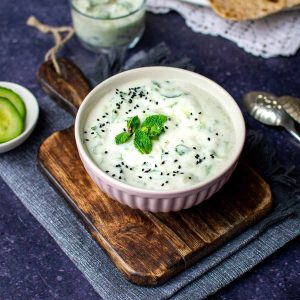
Mango Raita: A Detailed Guide to the Recipe
### Mango Raita: An Invigorating Indian Treat
Mango raita, commonly referred to as aam ka raita, is a delightful Indian side dish that melds the sweetness of luscious mangoes with the smooth consistency of yogurt, spiced with a mixture of seasonings. This dish is especially favored during the scorching summer season in India, when mangoes are abundant from April to June. The cooling attributes of yogurt make mango raita an ideal addition to fiery meals, offering a refreshing contrast.
#### Ingredients
The essential ingredients for mango raita comprise:
– Ripe mangoes
– Fresh yogurt (dahi)
– Red chili powder or cayenne
– Roasted cumin powder
– Chaat masala
– Black salt
– Fresh mint or coriander (optional)
– Pomegranate seeds (optional for garnish)
#### Preparation
Creating mango raita is remarkably easy and can be accomplished in less than five minutes. Here’s a quick walkthrough to make this tasty dish:
1. **Prepare the Mangoes**: Peel and dice ripe mangoes into small pieces. The sweetness of the mangoes is crucial for the raita’s flavor.
2. **Mix the Yogurt**: In a bowl, whisk fresh yogurt until smooth. You can modify the yogurt’s thickness based on your preference.
3. **Combine Ingredients**: Toss the diced mangoes into the yogurt. Sprinkle the red chili powder, roasted cumin powder, chaat masala, and black salt. Gently mix to blend all the ingredients without crushing the mangoes.
4. **Garnish**: If you like, add fresh mint or coriander for a splash of color and taste. Pomegranate seeds can also be included for added crunch.
5. **Chill and Serve**: Place the raita in the refrigerator for a while before serving to amplify its cooling effects. Serve it alongside rice, biryani, or any Indian dish.
#### Nutritional Benefits
Mango raita is not only tasty but also loaded with nutritional advantages. Yogurt is an excellent source of probiotics, which help in digestion and support gut health. Mangoes are abundant in vitamins A and C, delivering vital nutrients and antioxidants. This dish is light on the digestive system, hydrating, and can be a wholesome enhancement to your diet.
#### Serving Suggestions
Mango raita complements a variety of Indian dishes, making it an adaptable condiment. It can be served beside:
– Flavorful rice dishes
– Biryani
– Parathas
– Spicy curries
On sweltering summer days, mango raita, along with other mango-based treats such as mango phirni and aam ki lassi, offers a delightful relief from the heat.
#### Conclusion
Mango raita is a beloved recipe in numerous Indian households, renowned for its ease, taste, and health advantages. This summer, savor the sweet and tangy delight of aam ka raita, and relish a taste of India’s rich culinary tradition.
Read More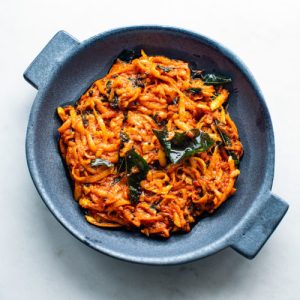
Raw Mango and Sesame Seeds Relish (Mamidikaya Nuvvula Pachadi)
### Mamidikaya Nuvvula Pachadi: An Andhra Style Raw Mango Chutney
Mamidikaya nuvvula pachadi is a classic Andhra chutney that harmoniously blends the zesty taste of raw mango with the nutty depth of toasted sesame seeds. This chutney, famed for its lively flavor and creamy consistency, acts as a wonderful complement to steamed rice, roti, or dosa.
#### Ingredients
– **Raw Mango (Mamidikaya)**: 1 medium, grated
– **Roasted Sesame Seeds (Nuvvulu)**: 2 tablespoons
– **Whole Red Chilies**: 2-3, according to heat preference
– **Cumin Seeds**: 1 teaspoon
– **Curry Leaves**: A few
– **Salt**: To taste
– **Oil**: 1 tablespoon (for tempering)
#### Preparation Steps
1. **Prepare the Raw Mango**: Peel and grate the raw mango. Ensure that the mango is not excessively sour; a sweet-tart flavor is perfect to balance the chutney.
2. **Roast the Sesame Seeds**: In a dry pan, toast the sesame seeds on low heat until they turn golden brown and emit a nutty fragrance. Take care not to scorch them.
3. **Tempering**: In the same pan, warm the oil. Add cumin seeds, whole red chilies, and curry leaves. Sauté until the cumin seeds pop and the curry leaves become crunchy.
4. **Combine Ingredients**: In a mixing bowl, mix the grated raw mango, roasted sesame seeds, and the tempered spices. Add salt to taste and stir well.
5. **Serve**: Place the chutney in a serving bowl. Mamidikaya nuvvula pachadi can be served right away or allowed to sit briefly to deepen the flavors.
#### Serving Suggestions
Mamidikaya nuvvula pachadi pairs wonderfully with:
– **Steamed Rice**: A spoonful of ghee on top elevates the flavors.
– **Roti or Dosa**: Use it as a spread or side condiment.
– **Crackers**: It also serves as a tasty dip.
#### Conclusion
This straightforward yet delicious chutney is a fundamental part of numerous Andhra households and is adored for its sentimental connections to family customs. The mix of the acidity of raw mango and the creaminess of sesame seeds results in a distinctive flavor that is both invigorating and fulfilling. As raw mangoes are currently in season, this is the ideal moment to attempt making mamidikaya nuvvula pachadi and relish its wonderful flavors.
Read More
Raw Mango and Moong Dal Salsa (Mamidikaya Pesarapappu Pachadi)
### Mamidikaya Pesarapappu Pachadi: An Exquisite Andhra Style Chutney
Mamidikaya pesarapappu pachadi is a renowned culinary treasure from Andhra Pradesh, India. This age-old chutney, crafted from raw mango and moong dal (yellow lentils), is a fundamental dish in Telugu households, particularly during the mango season. Renowned for its vibrant orange hue and robust flavors, this chutney complements steamed rice and a spoonful of ghee perfectly, making it an indispensable element of any Andhra thali.
#### Ingredients and Nutritional Advantages
The charm of mamidikaya pesarapappu pachadi rests in its straightforwardness. The primary components include:
– **Raw Mango**: Offers a tangy taste and is abundant in Vitamin C and antioxidants.
– **Moong Dal**: Serves as a good source of protein and vital nutrients.
– **Jaggery**: Introduces a mild sweetness that offsets the tartness of the mango.
– **Spices**: Dry roasted cumin, red chilies, mustard seeds, split urad dal, and fresh curry leaves enrich the flavor profile.
This chutney is not only flavorsome but also nutritious, providing a mix of protein, vitamins, and minerals.
#### Flavor Profile
Mamidikaya pesarapappu pachadi exemplifies how a few ingredients can yield rich flavors. The tartness of the raw mango, the sweetness of jaggery, the earthiness of roasted moong dal, and the spiciness from red chilies blend harmoniously to create an enticing taste sensation. The tempering of mustard seeds, urad dal, and curry leaves adds a lively element that enhances the chutney even more.
#### Preparation Method
1. **Roasting Moong Dal**: Begin by dry roasting the moong dal until it achieves a golden brown color. This step is vital as it amplifies the dal’s flavor.
2. **Grinding the Ingredients**: In a blender, mix the roasted moong dal, peeled raw mango, jaggery, cumin, and red chilies. Blend to a coarse paste, adjusting the consistency with water as necessary.
3. **Tempering**: In a small saucepan, heat oil and include mustard seeds, split urad dal, and asafoetida. Once the mustard seeds pop, add fresh curry leaves and sauté for a few seconds. Drizzle this tempering over the chutney.
4. **Serving**: Present mamidikaya pesarapappu pachadi alongside steamed rice and a dollop of ghee. It can also be savored as a dip or spread.
#### Conclusion
Mamidikaya pesarapappu pachadi is a vegetarian delight of Andhra cuisine that highlights the region’s passion for pachadis. Its distinctive fusion of sour, spicy, and sweet flavors makes it a must-savor for anyone who appreciates South Indian food. Whether you seek a side dish or a zesty dip, this chutney is bound to captivate. Celebrate the mango season by trying this delightful recipe and relish the authentic flavors of Andhra Pradesh.
Read More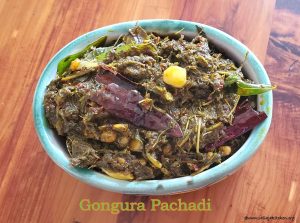
Andhra-Style Green Mango Curd Chutney (Mamidikaya Perugu Pachadi)
### Mamidikaya Perugu Pachadi: A Cool Raw Mango Chutney
Mamidikaya perugu pachadi is an authentic Andhra-style chutney crafted from raw mango and yogurt, infused with Indian spices. This charming dish is a vital part of South Indian fare, particularly throughout the summer when mangoes are plentiful. It acts as a wonderful accompaniment, enhancing rice, dal, and an array of vegetable curries, making it an ideal component of a conventional Andhra thali.
#### Ingredients
– Raw mango (peeled and cut into pieces)
– Fresh yogurt (thick and mild)
– Mustard seeds
– Split gram dal (urad dal)
– Dry red chilies
– Asafoetida (hing)
– Curry leaves
– Shallots (optional)
– Salt to taste
#### Preparation Method
1. **Sauté the Mango**: In a pan, heat some oil and toss in mustard seeds. Once they begin to pop, introduce split gram dal, dry red chilies, asafoetida, and curry leaves. Sauté until the dal takes on a golden hue. Add the diced raw mango and cook for a few minutes until it softens slightly.
2. **Mix with Yogurt**: In a mixing bowl, place fresh yogurt and whisk it until smooth. Incorporate the sautéed mango mixture into the yogurt, blending thoroughly. If using, finely chop shallots and add them for extra flavor.
3. **Seasoning Adjustment**: Sprinkle salt to taste and mix well. Ensure the chutney balances the tartness of the mango with the creaminess of the yogurt.
4. **Serving**: Mamidikaya perugu pachadi can be enjoyed right away or chilled for a refreshing flavor. It pairs beautifully with plain rice, rotis, or any meal as a side.
#### Variations
There exists a variation of mamidikaya perugu pachadi where fresh coconut and green chilies are blended into a paste and combined with the yogurt instead of sautéing the mango. This version introduces a different texture and taste profile, elevating the overall flavor of the chutney.
#### Nutritional Benefits
Mamidikaya perugu pachadi is not only tasty but also healthy. Raw mango is high in vitamins A and C, while yogurt contributes probiotics beneficial for gut health. This chutney is an excellent method to integrate seasonal produce into your meals, providing a refreshing and tangy flavor ideal for hot summer days.
#### Conclusion
Mamidikaya perugu pachadi is a straightforward yet flavorful dish that captures the spirit of Andhra cuisine. Its quick preparation makes it a perfect choice for hectic days, allowing you to relish the seasonal bounty of raw mangoes. Whether served with rice or used as a dip, this chutney is guaranteed to please family and friends alike.
Read More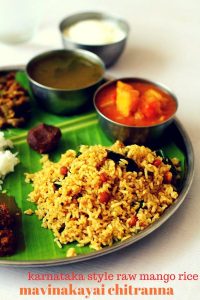
Mavinakayi Chitranna Recipe: Karnataka-Style Mango Rice
### Mavinakayi Chitranna Recipe: A Karnataka Style Raw Mango Rice Dish
Mavinakayi Chitranna, an exquisite rice preparation from Karnataka, highlights the zesty essence of raw mango, merging spicy, sweet, and tangy tastes to create an irresistible delight. This recipe holds a special place in South Indian cuisine, typically relished during the mango season.
#### Ingredients
– **For the Rice:**
– 450-500 grams uncooked rice
– Water (for cooking rice)
– **For the Gojju (Spice Mix):**
– 1 medium-sized raw green mango (grated)
– 2 tablespoons sesame oil (or any cooking oil)
– 1 teaspoon mustard seeds
– 2 tablespoons chana dal (split chickpeas)
– 1 teaspoon urad dal (split black gram)
– 2-3 dried red chilies
– 1/4 teaspoon turmeric powder
– 1-2 tablespoons jaggery (adjust to taste)
– Salt (to taste)
– Fresh coriander leaves (for garnish)
– **For Chitranna Masala Powder:**
– 1 tablespoon chana dal
– 1 tablespoon urad dal
– 1 tablespoon sesame seeds
– 1 teaspoon cumin seeds
– 1 teaspoon black pepper
– 2-3 dried red chilies
– 1/2 teaspoon asafoetida (hing)
#### Instructions
1. **Prepare the Rice:**
– Rinse the uncooked rice thoroughly until the water is clear. Cook the rice in a pot or rice cooker with the right amount of water until tender but each grain stays distinct. Allow it to cool.
2. **Make the Chitranna Masala Powder:**
– In a dry skillet, lightly roast each ingredient for the masala powder individually over low-medium heat until they emit a pleasant aroma. Take care to prevent burning.
– Once roasted ingredients have cooled, grind them into a fine powder using a spice grinder or mortar and pestle. Set aside.
3. **Prepare the Gojju:**
– Heat sesame oil in a pan. Add mustard seeds and let them pop.
– Incorporate chana dal, urad dal, and dried red chilies. Sauté until the dals reach a golden brown hue.
– Mix in the grated raw mango, turmeric powder, jaggery, and salt. Cook for several minutes until the mango becomes tender.
– Stir in the prepared chitranna masala powder and combine well. Cook until the oil separates from the mixture, signifying it is thoroughly cooked.
4. **Combine Rice and Gojju:**
– In a large mixing bowl, combine the cooled rice with the mango gojju. Gently mix to ensure the rice is well-coated with the mixture.
5. **Serve:**
– Garnish with fresh coriander leaves. Mavinakayi Chitranna can be served warm or at room temperature, making it a fantastic choice for lunch boxes or picnics. Pair it with yogurt and crispy snacks like papad or appadam for a complete meal.
#### Tips
– Select a tart raw mango for optimal flavor.
– Let the dish sit for a couple of hours prior to serving to enhance the mingling of flavors.
– The gojju can be refrigerated for later use, providing convenience for quick meals.
Mavinakayi Chitranna is more than just a meal; it’s a tribute to flavors that reflect the heart of Karnataka’s culinary tradition. Savor this wholesome dish that promises to elevate your day!
Read More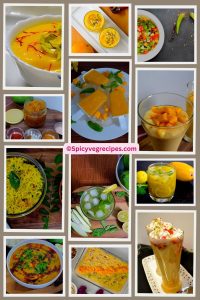
Recipe for Amrakhand: Guide to Preparing Mango Shrikhand
### Amrakhand: A Tasty Mango Shrikhand Recipe
Amrakhand, widely recognized as mango shrikhand, is a scrumptious and classic Indian dessert originating from Maharashtra. This sweet dish beautifully blends the luscious flavors of ripe mango puree with hung curd or yogurt, yielding a creamy, delectable treat that is ideal for summer.
#### Ingredients
– 2 cups hung curd (strained yogurt)
– 1 to 1.5 cups ripe mango puree (adjust based on sweetness)
– 1/2 cup powdered sugar (adjust to taste)
– 1/4 teaspoon cardamom powder
– A few strands of saffron (optional)
– Chopped ripe mango pieces (optional, for garnish)
#### Preparation of Hung Curd
1. **Straining Yogurt**: To prepare hung curd, place a muslin cloth or a fine sieve over a bowl. Pour in the yogurt and allow it to strain for 2-4 hours in the refrigerator until all the whey has drained out. This will yield a thick, creamy texture akin to cream cheese.
#### Making Amrakhand
1. **Combine Ingredients**: In a mixing bowl, whip the hung curd until it becomes smooth and fluffy.
2. **Add Mango Puree**: Gradually incorporate the ripe mango puree until thoroughly blended.
3. **Sweeten**: Add powdered sugar to taste, mixing well to ensure even distribution.
4. **Flavoring**: Mix in the cardamom powder and saffron strands for enhanced flavor.
5. **Adjust Consistency**: If preferred, gently fold in chopped mango pieces for added texture and flavor.
#### Serving Suggestions
Amrakhand can be enjoyed in multiple ways:
– **As a Dessert**: Serve chilled in bowls as a refreshing dessert.
– **With Roti or Puri**: Traditionally, it pairs well with Indian flatbreads like roti or puri.
– **Frozen Treat**: You can freeze amrakhand for a delightful summer treat that children will enjoy.
#### Tips for Perfect Amrakhand
– **Quality of Mangoes**: Opt for sweet, pulpy, and ripe mangoes for optimal flavor. The sweetness of the mango will dictate the amount of sugar required.
– **Yogurt Quality**: Ensure the yogurt is fresh and not overly sour, as this can influence the overall taste.
– **Straining Time**: Strain the yogurt in the refrigerator to avoid it turning sour due to heat.
Amrakhand is not only a delightful dessert but also a gluten-free choice, making it perfect for summer gatherings. Its creamy texture and fruity taste make it a beloved dish in many homes, particularly during the mango season. Savor this delightful treat as part of your summer meals or as a refreshing dessert on its own!
Read More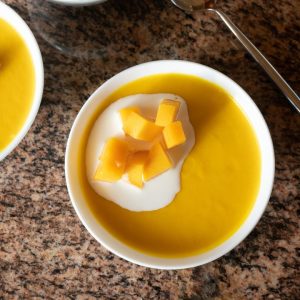
Recipe for Mango Dessert
### Mango Pudding Recipe: A Simple and Tasty Eggless Dessert
Mango pudding is a delightful and easy dessert that embodies the spirit of summer with its delicious mango taste. This egg-free recipe utilizes agar agar, milk, mango puree, and sugar, making it an excellent choice for those who prefer vegan options or are avoiding eggs. With few ingredients and clear instructions, this pudding is perfect for cooks of all ages, including kids.
#### Ingredients
– 2 cups ripe mango puree (approximately 2-3 ripe mangoes)
– 1 cup skimmed milk (or coconut milk for a vegan alternative)
– 2 tablespoons agar agar (either powder or strips)
– 1/4 cup sugar (adjust according to mango sweetness)
– Optional: Chopped mango for decoration, soaked sabja (basil seeds), or chopped nuts for additional texture
#### Instructions
1. **Prepare the Agar Agar**: If using agar agar strips, immerse them in water for about 10-15 minutes until softened. For agar agar powder, dissolve it in 1/2 cup of warm water.
2. **Heat the Milk**: In a saucepan, warm the milk over medium heat. When it begins to heat up, add the soaked agar agar (or the dissolved powder) and stir continuously until fully dissolved.
3. **Combine Ingredients**: In a blender, mix the mango puree and sugar. Blend until smooth. Then, incorporate the warm milk mixture into the blender and blend again until thoroughly mixed.
4. **Set the Pudding**: Transfer the mixture into serving bowls or shot glasses. Let it cool to room temperature before placing it in the refrigerator. Allow it to set for at least 2-3 hours or until firm.
5. **Serve**: Once firm, top with chopped mango, soaked sabja, or nuts as desired. Serve chilled for a refreshing dessert.
#### Tips for the Perfect Mango Pudding
– **Select the Right Mangoes**: Opt for ripe mango varieties such as Alphonso, Kesar, or Banganapalli for optimal flavor and texture. These types have soft flesh and less fiber, making them perfect for pudding.
– **Modulate Sweetness**: Depending on how sweet the mangoes are, you might want to modify the amount of sugar. Taste the mango puree before adding sugar to achieve the right balance.
– **Vegan Alternative**: For a vegan version, just swap skimmed milk with coconut milk. This not only makes it vegan but also enhances the tropical flavor of the dessert.
– **Presentation**: Serve the pudding in stylish shot glasses for events or gatherings. The bright color of the mango pudding will be visually attractive and a favorite among guests.
Mango pudding is not only a delightful dessert but also a flexible treat that can be enjoyed in numerous ways. Whether you’re hosting a summer gathering or indulging in a sweet treat, this simple-to-make pudding is sure to impress. Savor the heavenly taste of mangoes in every bite!
Read More